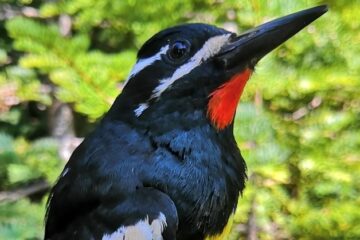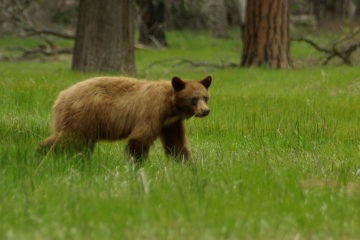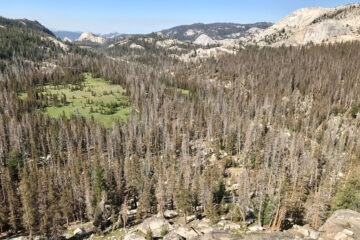Here at Yosemite Conservancy, the new year always marks a new chapter. We wrap up one year of projects and announce a new set of grants to Yosemite National Park. Our program teams gear up for a new season of helping people connect with Yosemite, including through naturalist-led adventures and outdoor art classes.
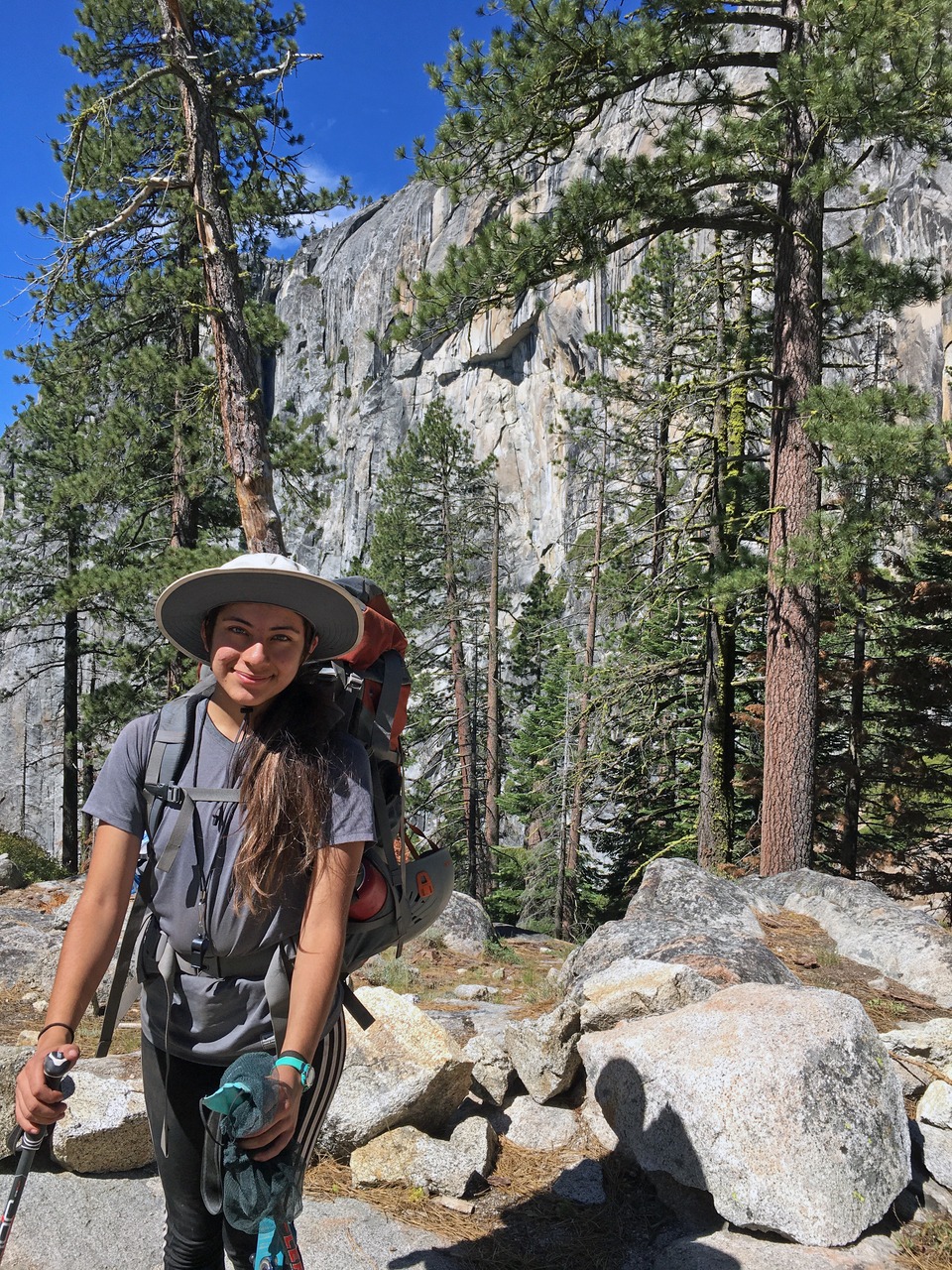
2020 upended a lot of things, but the value of spending time outside held steady. On a COVID-adapted summer course, Adventure Risk Challenge students experienced the power of connecting with nature. Photo: Courtesy of ARC.
This January, it’s a little harder than usual to embrace the symbolic promise of a fresh year. While 2020 formally slid into past tense after December 31, the flip of a calendar page doesn’t erase the sorrow, stress and uncertainty of the past many months. The pandemic rages and ravages on, and 2021 already seems to be trying its best to match the notoriety of the past year.
A variety of descriptors could be attached to 2020 (unprecedented, devastating and calamitous come to mind) but for the Conservancy, one word rises above the rest: Gratitude. We’re grateful for our team, for our partners in the National Park Service, and for everyone who supported the Conservancy, whether as a donor, a program participant, or an enthusiastic social media fan spreading the word about ways to connect with Yosemite.
We’re grateful, especially, because you, the Conservancy community, made so much possible in 2020!
Wildlife work
Thanks to your support last year, park crews installed 61 new bear-proof food lockers at Wawona campsites; that effort freed up dozens of existing, smaller lockers to be donated to nearby public lands, to help protect bears and other wildlife beyond Yosemite.
Biologists monitored 15 active peregrine falcon nest sites and managed climbing areas to maximize recreational access while protecting baby raptors; released more than 100 Sierra Nevada yellow-legged frogs in high country lakes; and caught glimpses of endangered bighorn sheep, including multiple lambs, during seasonal surveys of the Yosemite-area herds.
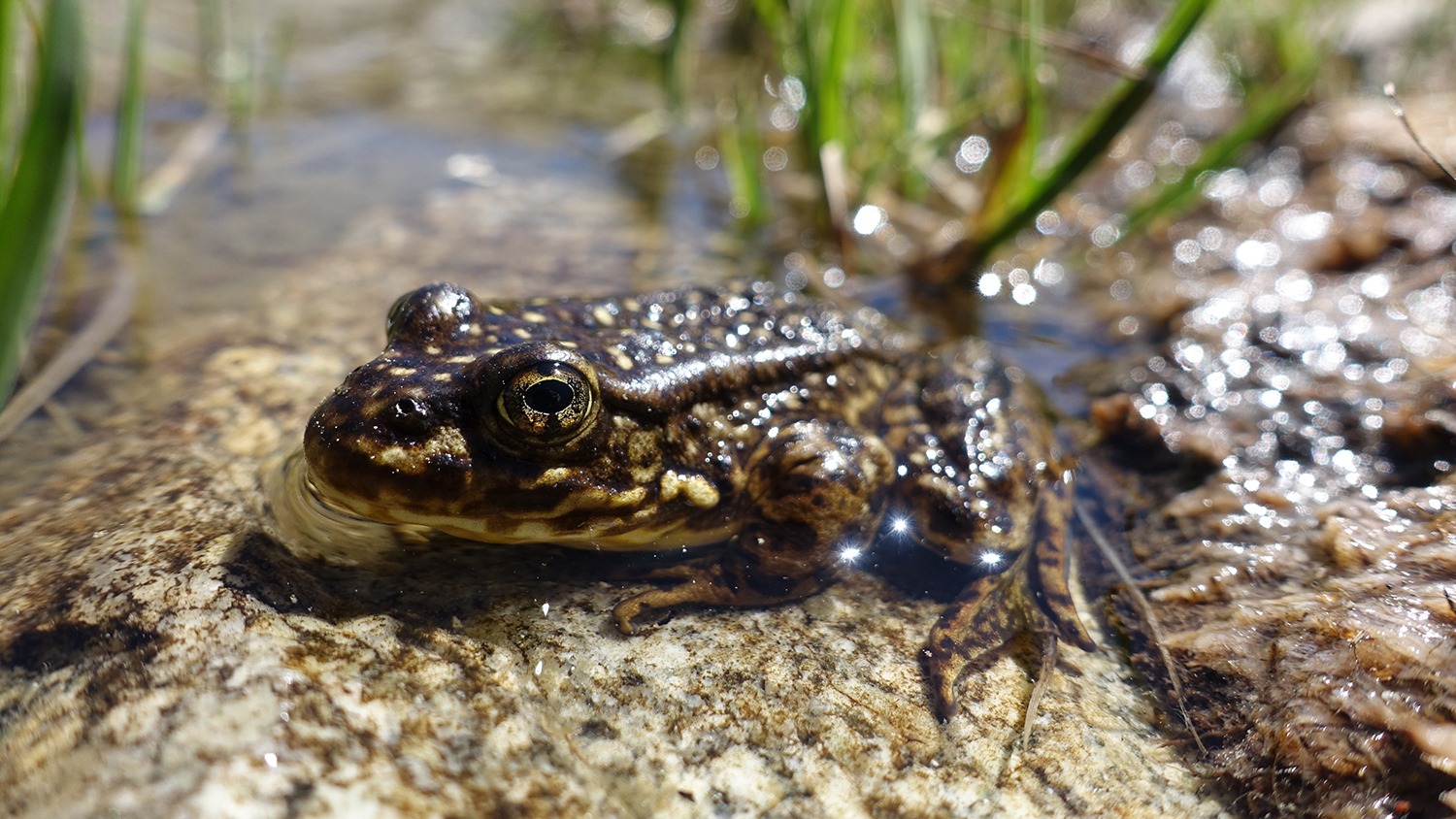
A Sierra Nevada yellow-legged frog in Yosemite’s high country. Photo: Courtesy of NPS.
Biologists and specially trained “detection dogs” completed a second year of research on Yosemite’s Sierra Nevada red fox and mountain lion populations. During the 2020 season, scent dogs and their handlers, known as “bounders,” covered 560 square miles and collected more than 1,000 droppings as they searched for scat from mountain lions (also called cougars) and red foxes, as well as from other carnivores, including fishers, bobcats and pine martens. Researchers at the University of California, Davis, are analyzing the samples to figure out which animals left them behind. (Last year, that analysis revealed one sample from a red fox and 57 from mountain lions, and the Yosemite team anticipates the 2020 survey collections will yield even more identifications.)
Scientists are also using remote cameras to capture photos of the elusive foxes and cougars. In 2019, remote cameras took 712 snapshots of mountain lions; in 2020, cougars padded by at least 23 of the 42 camera sites. As of December 2020, researchers had tallied 30 Sierra Nevada red fox detections since 2014, through a combination of camera sightings and scat samples.
“Each encounter with wildlife — through sightings, tracks, signs, and camera images — teaches me more about this incredible park and emphasizes the importance of the work we’re doing to protect it.”
— Sarah Sugarman, 2020 wildlife researcher (and Yosemite’s Yosemite Volunteer of the Year!)
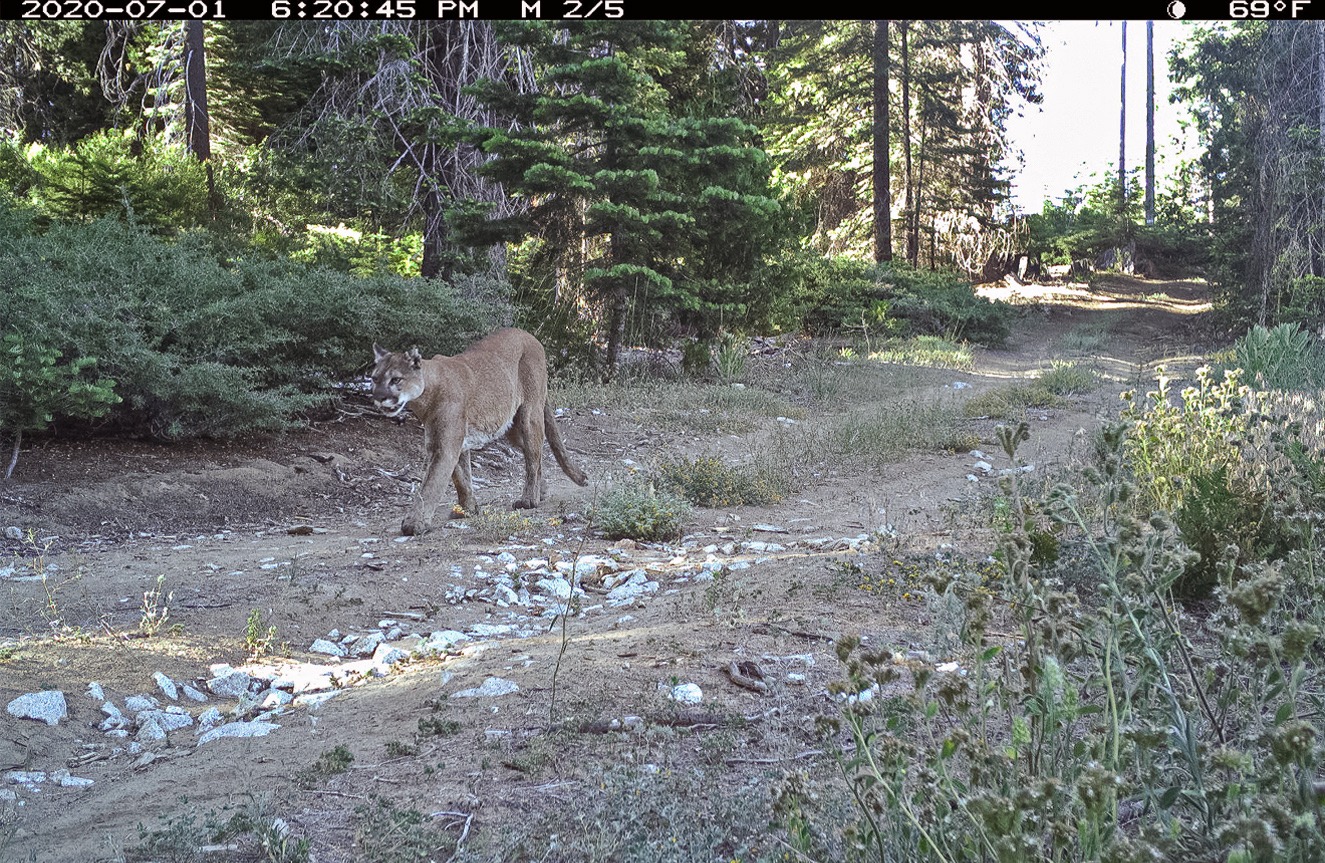
A remote camera captured this photo of a mountain lion on a Yosemite trail in July 2020. Photo: Courtesy of NPS.
Helping trails and habitat
While wildlife researchers scanned alpine plateaus, hiked to remote lakes and peered up at Valley cliffs to study and protect sheep, frogs, foxes and falcons, restoration crews worked to revive the habitats on which Yosemite’s animals depend. Despite COVID-related challenges, including far fewer volunteers than usual, they made notable progress on ecological restoration projects in the Valley and throughout the Yosemite Wilderness.
The park’s Keep It Wild crew covered nearly 1,300 acres while identifying and restoring backcountry areas in need of TLC, traveling on foot to places such as Kerrick Meadow, Lyell Canyon, Little Yosemite Valley, and Fletcher, Peeler and Evelyn lakes. During their days in the wilderness, they worked on 68 informal campsites left behind by backpackers, maintaining acceptable sites and shrinking or removing those deemed too large, too close to water, or otherwise unsuitable. When smoke flooded summer skies, they shifted their attention to preparing seeds for future planting projects and safeguarding Mariposa Grove as the Creek Fire blazed not far from the famed giant sequoias.
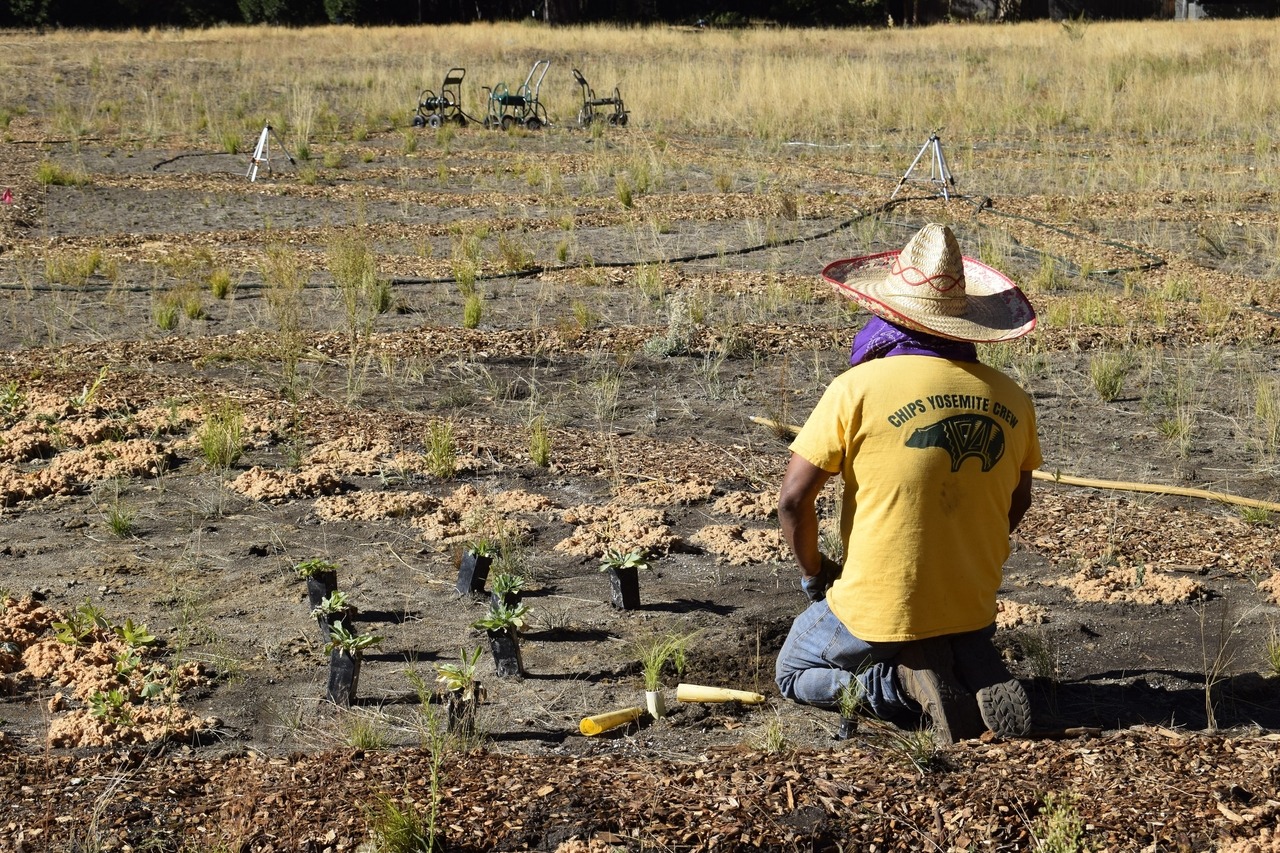
A CHIPS (Calaveras Healthy Impact Product Solutions) crew member plants seedlings in Ahwahnee Meadow in October 2020. Photo: Yosemite Conservancy/Ryan Kelly.
In the Valley, another season of work to improve habitat for monarch butterflies and other pollinators moved ahead, with a focus on areas in Ahwahnee Meadow and Cook’s Meadow, as well as near the Rangers’ Club and Lower Yosemite Fall. The NPS team worked with Yosemite-area volunteers, including families, park employees, and a Calaveras Healthy Impact Product Solutions (CHIPS) crew composed of local tribal members, to restore 6.9 acres of prime pollinator habitat, sow more than 6,000 plants, and gather seeds for future revegetation work.
“I am so appreciative for projects such as these, designed to share restoration experiences with visitors and highlight the importance of native plants, from Yosemite Valley to the backyard garden. To a monarch, Yosemite is just another stop, albeit an important and beautiful one, in a string of migratory stops across backyards and Wilderness alike.”
— Melissa Booher, biologist working on the 2020 pollinator plants project
Meanwhile, crews made progress on reviving wetlands elsewhere in the Valley. They installed a boardwalk and planted native vegetation near Lower River Amphitheater, to reconnect recently restored and existing wetlands; removed conifers that were threatening wetlands near Yellow Pines; and created a map showing potential sites for future wetland restoration, including areas that could support California red legged frogs.
Trail crews, including young adults from the California Conservation Corps, repaired hiking routes throughout the park. They cleared debris from the Yosemite Falls Trail, installed new railings to keep people safe on the Mist Trail, restored eroded hiking terrain near Clouds Rest, improved access trails for popular climbing areas in Tuolumne Meadows and the Valley, and much more.
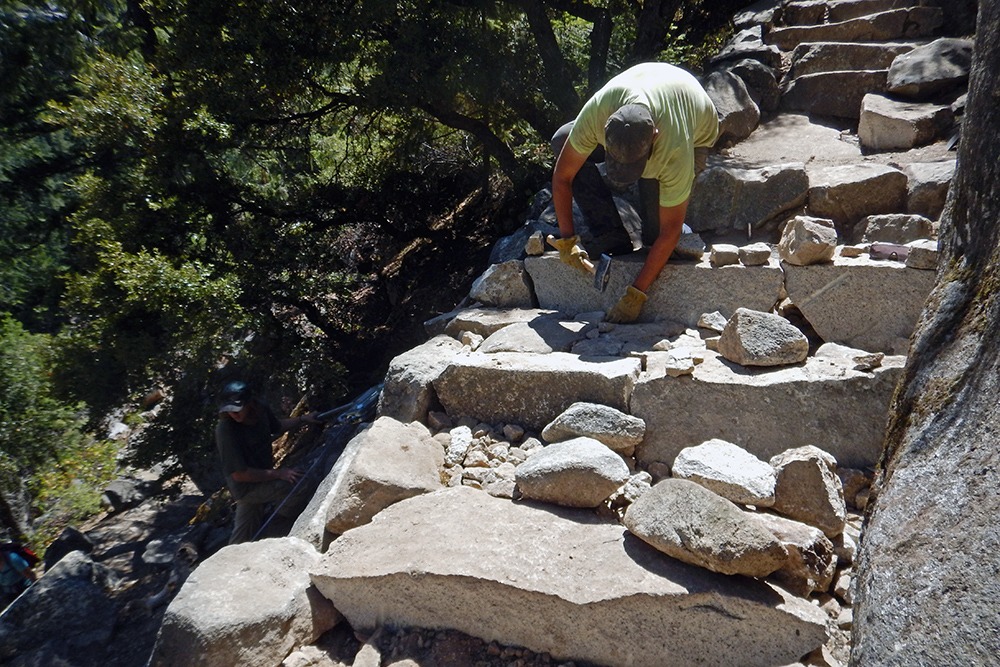
A trail crew works on steps near Clark Point, on the John Muir Trail, as part of 2020 Conservancy-supported restoration work on popular routes in and around Yosemite Valley. Photo: Courtesy of NPS.
Innovative education
Between a temporary spring closure and public health guidance on staying safely away from other people, the pandemic muddled many original plans for Conservancy-funded educational programs in the park. But our partners at the NPS and beyond quickly adapted and found ways to keep people connected with Yosemite in person and online!
Yosemite educators came up with Junior Ranger videos and live-streamed sessions for children and families to watch from home, including a virtual camp-out and a “Kids Ask Rangers” series that encouraged young learners to “stay curious” about nature. Over the course of the year, they reached more than 450,000 people around the world and inspired other national parks to try similar online outreach.
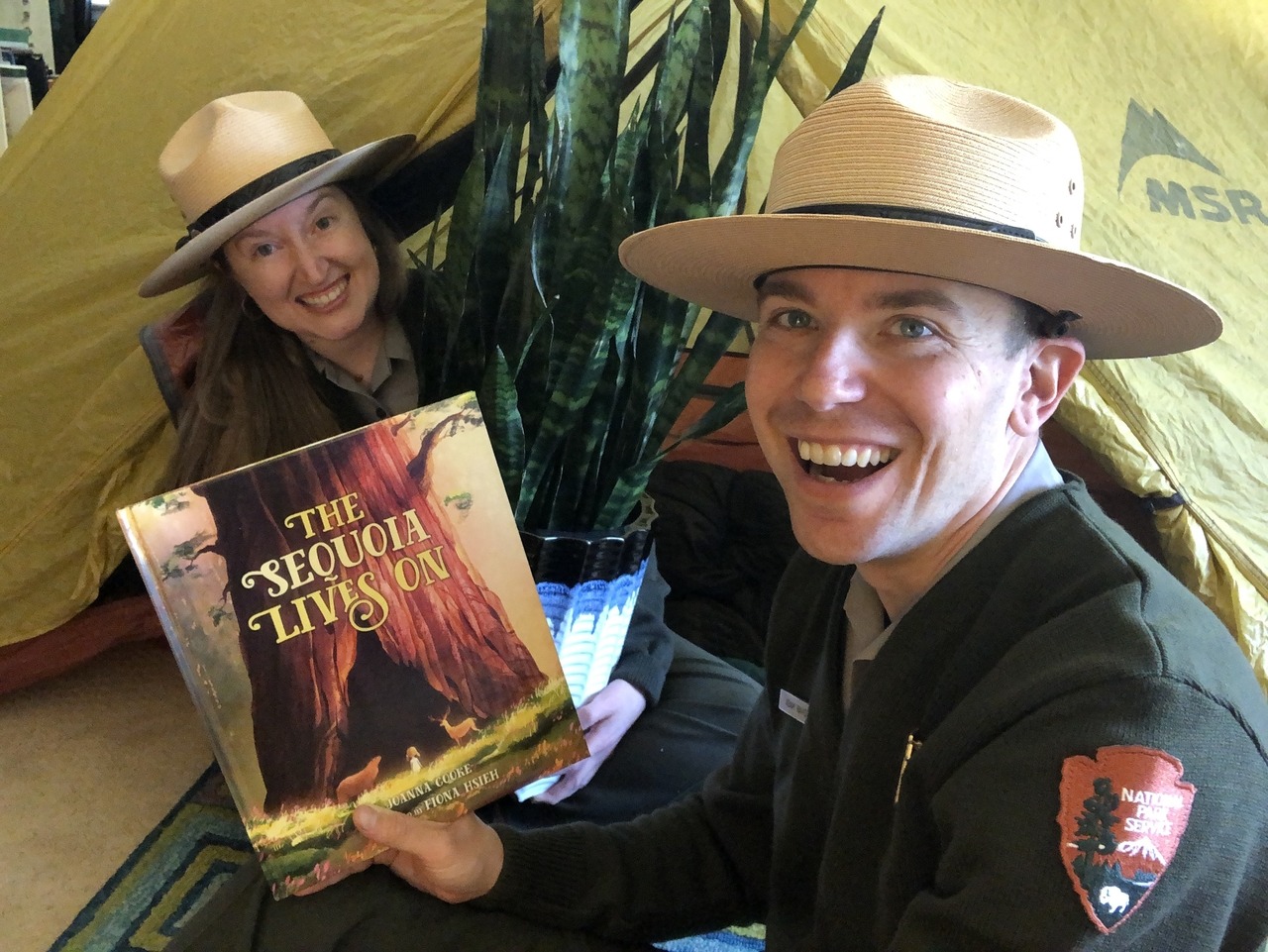
Yosemite educators brought Junior Ranger outreach online in 2020, including through online camp-outs and activities. In one video, they read and talked about The Sequoia Lives On, a Conservancy-published children’s book by Joanna Cooke and Fiona Hsieh. Photo: Courtesy of NPS.
Donor supported youth-programs such as Adventure Risk Challenge and WildLink transformed their approaches to make sure their high-school-age participants could still connect with nature and one another. ARC program leaders offered a modified version of their immersive Sierra Nevada summer course, and the WildLink team created new curriculum that teachers and students at partner schools could follow online or in person.
The Parsons Memorial Lodge Summer Series, which usually takes place in Tuolumne Meadows, was shared safely with tens of thousands of people through recorded presentations, poetry readings, musical performances and storytelling sessions. Climbing rangers, who usually interact with visitors in person through the seasonal Ask a Climber program, shared insights into the fascinating world of Yosemite climbing through videos and blogs.
And in an unexpected silver lining, the pandemic presented an ideal opportunity for rangers to experiment with pop-up educational activities that people could happen upon as they traveled around the park, including opportunities to draw and paint, learn about watersheds and glaciers, and write reflective postcards.
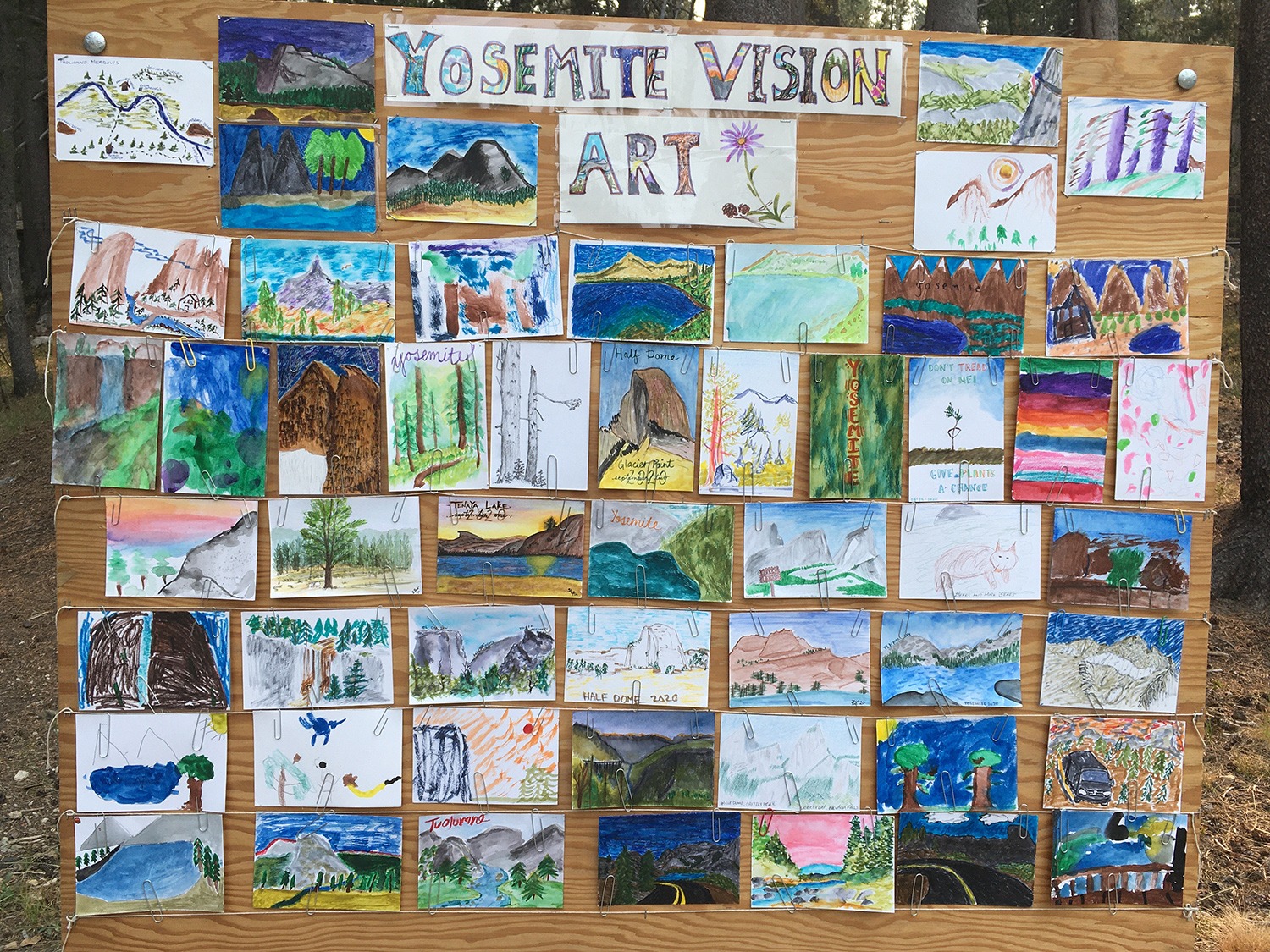
As part of new pop-up activities, rangers invited visitors to capture their experiences in the park through art. Photo: Courtesy of NPS.
Keeping you connected
On the note of innovation and adaptation, our team in the park adjusted to help people continue experiencing and learning about Yosemite safely, both in person and from afar. They created new videos to guide you through at-home art projects and get to know lichen and lupine, adapted naturalist-led adventure programs to include pandemic precautions, and re-envisioned the Conservancy bookstore at the Valley Visitor Center as a contact-free outdoor operation.
Conservancy team members also supported key park services, from helping to set up and manage an all-online wilderness permit system to staffing Preventive Search and Rescue stations along the Mist Trail, where they joined local volunteers and rangers to share important safety information with hikers heading to Vernal Fall, Nevada Fall and Half Dome.
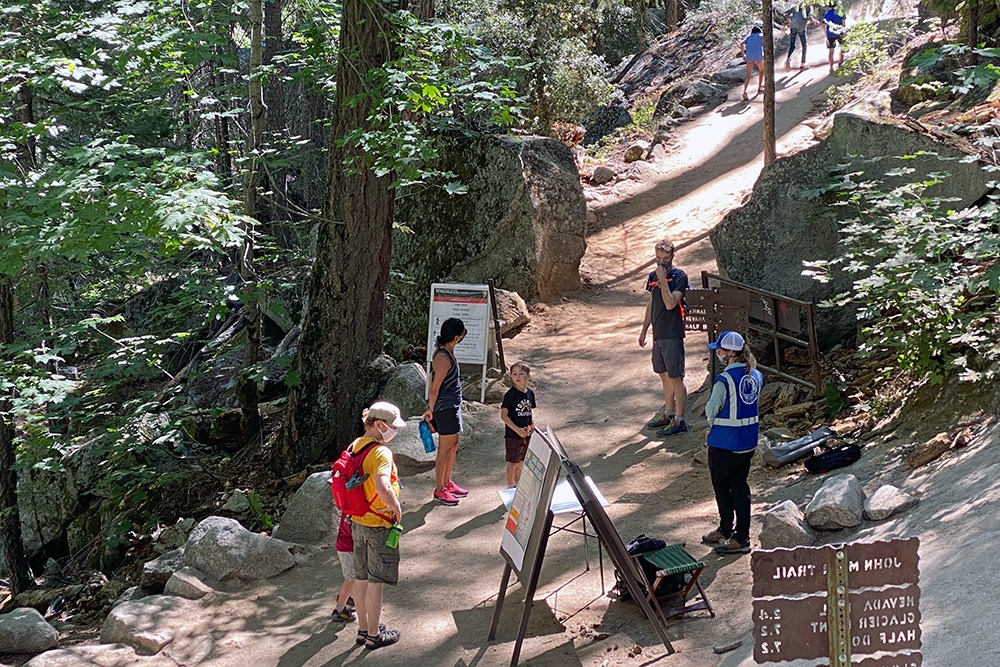
Conservancy staff and naturalists helped staff a Preventive Search and Rescue station at the junction of the Mist and John Muir trails, where they shared safety guidance and answered hikers’ questions. Photo: Courtesy of NPS.
Yosemite on display
Multiple educational exhibits took shape in 2020, thanks to donor-supported projects. New displays about climbing history and techniques were installed in the Valley Visitor Center, which has been closed since last spring due to the pandemic. Climbing-focused timelines, stunning photos, an array of gear, including a portaledge, await those interested in learning more about big wall ascents and the vertical wild when the building reopens. (In the meantime, get a sneak peek at the new exhibits in our November 2020 magazine.)
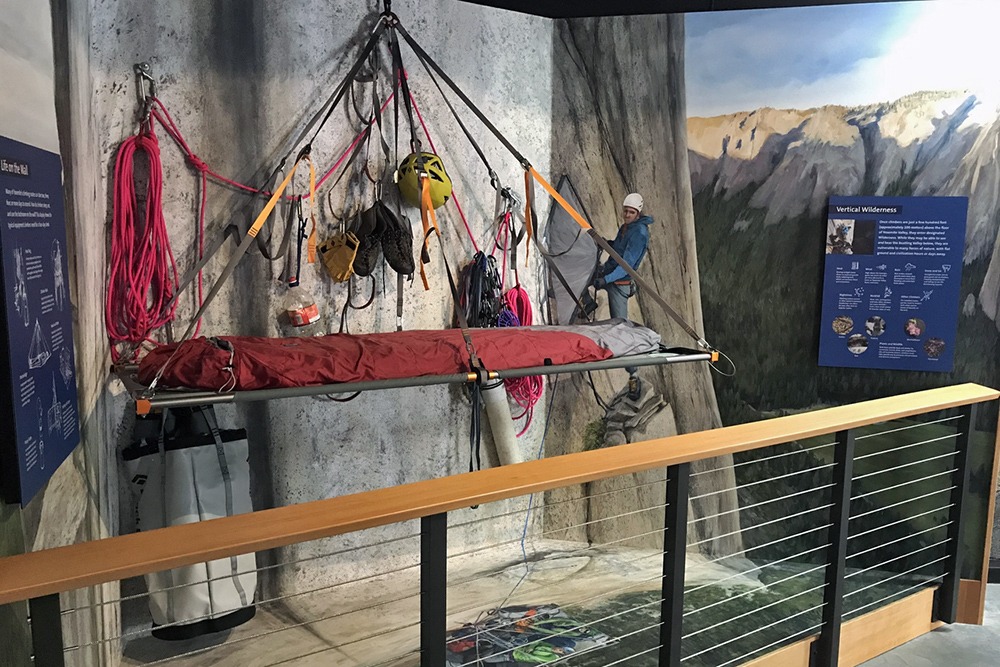
One of the displays featured in the new Climbing and Stewardship Exhibit at the Valley Visitor Center shows gear climbers might need for a multiday ascent. Photo: Yosemite Conservancy/Ryan Kelly.
Nearby, in the Valley Wilderness Center, a team is finalizing fresh displays that showcase the many ways people can experience and protect wilderness areas. Over the summer, park educators produced a digital exhibit on women throughout Yosemite’s history, in honor of the centennial of the 19th amendment, and they hope to welcome visitors to a physical exhibit on the same theme when pandemic precautions allow.
Speaking of centennials, another donor-supported project funded preservation work to shore up the faltering central fireplace in the century-old Rangers’ Club. Project manager Matt Bablitch shared this observation about working on the fireplace during a milestone year:
“To complete the restoration of this focal feature on such a magnificent and important structure, 100 years to the month, has been a source of inspiration and pride for the entire crew. When word got out around the park that we were executing this project many people dropped by to see the work in progress (at a safe six-foot distance of course.) It was great to see so many people take interest in the building and its story.”
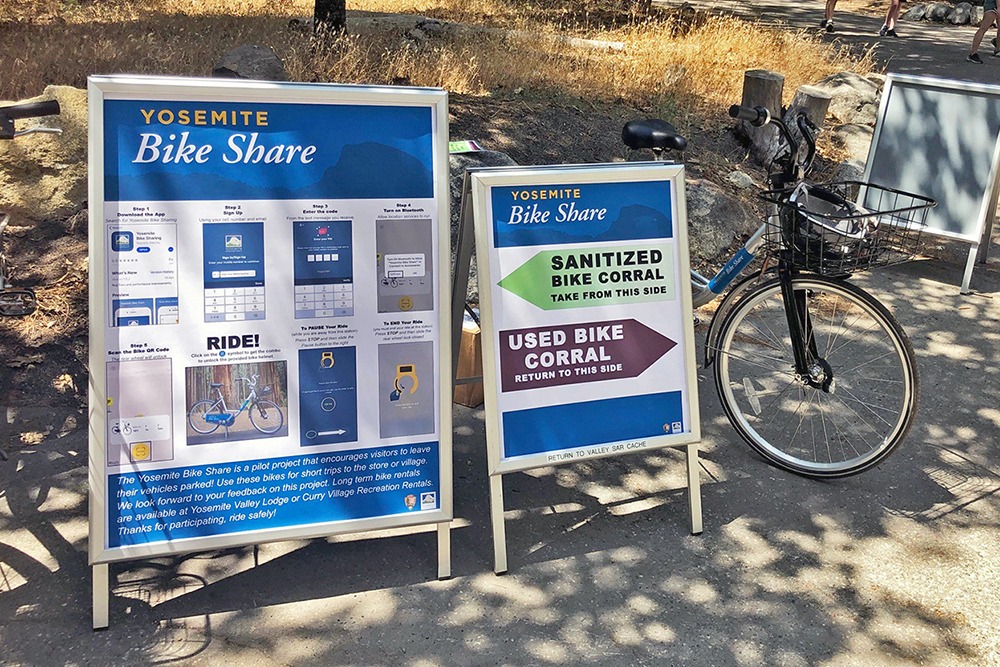
To keep riders safe during the pandemic, the Yosemite Bike Share team set up “Sanitized” and “Used” areas, and made sure bikes were thoroughly cleaned between each use. Photo: Yosemite Conservancy/Schuyler Greenleaf.
And last but not least, 2020 was an outstanding year for the Yosemite Bike Share! More than twice as many people took advantage of the free service as in 2019, and the bike share team honed pick-up/drop-off locations and made sure bikes were in good shape (and sanitized) for each rider.
None of this work — and the innovation, adaptation and perseverance that kept so many projects and programs moving forward in 2020 — would be possible without the support of the Conservancy community, from our donors, program participants and bookstore patrons; to our dedicated team; to our partners in the NPS and beyond, including at the University of California, NatureBridge, Adventure Risk Challenge, and more.
For so many people, Yosemite is an anchor in stormy times, a place that inspires, heals and endures. We’re awed, again and again, by the generosity and passion of people who care about the park and its future.
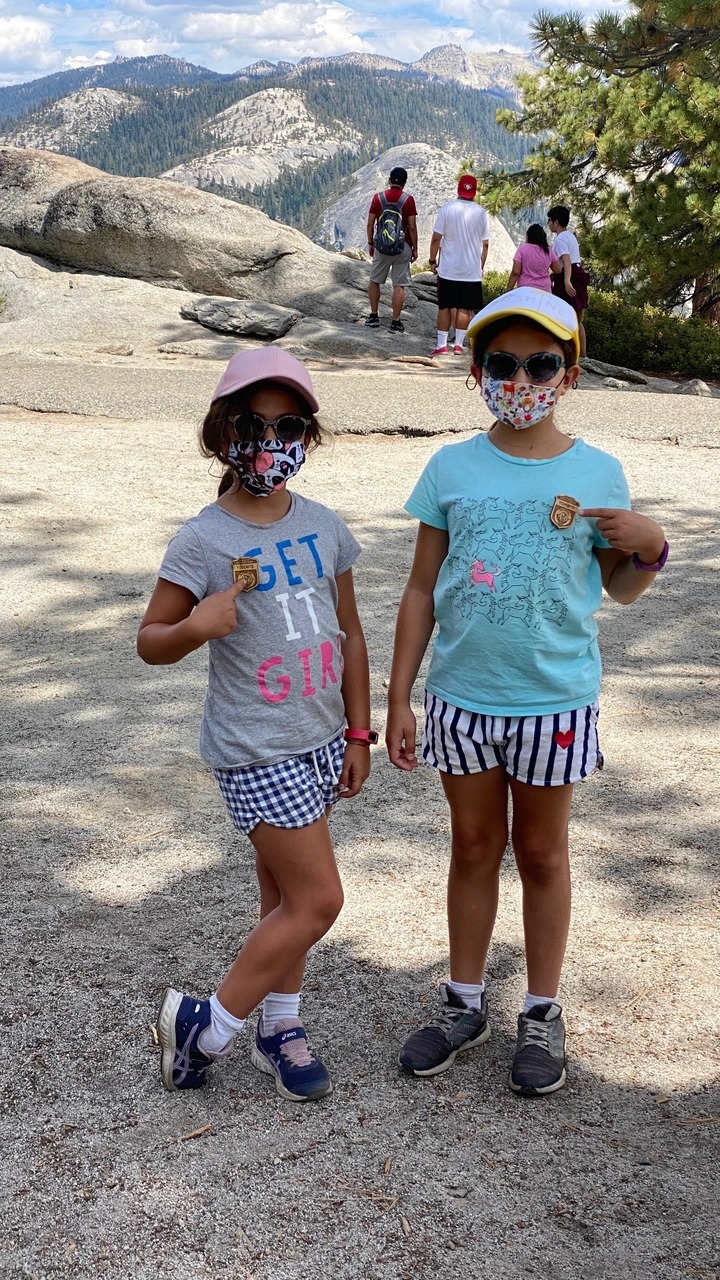
Even 2020 couldn’t stop Yosemite from inspiring the next generation to explore, learn about and protect the park! These two Yosemite fans got to earn (and then show off) their Junior Ranger badges over the summer. Photo: Courtesy of NPS.
We know there are many hard months ahead — and that 2021 will prompt even more creativity, flexibility and teamwork to keep people connected to Yosemite from near and far, and to make sure important work continues in the park. We’re bidding farewell to 2020 with deep thanks to everyone who supports the Conservancy, and starting the new year with gratitude as we continue pursuing our organization’s mission of supporting projects and programs that preserve Yosemite and enrich visitor experiences for all. Browse our 2021 grants to see some of the many ways you can make a difference in Yosemite this year!

